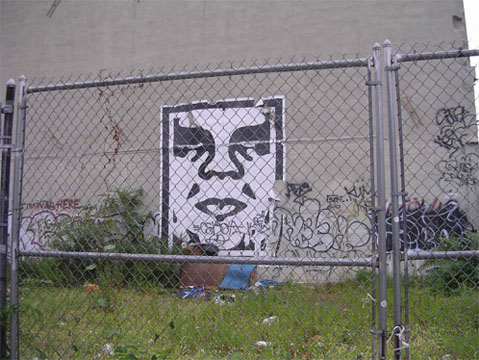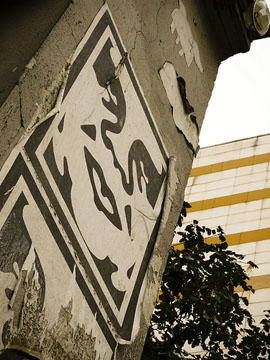
|
Examining Shepard Fairey's Street Art Through a Foucauldian Discourse Analysis: Page 2 |
 |
There is, however, another way altogether of interpreting the impact an institution can have upon the way in which an image is produced and produces certain subjects by virtue of being displayed in different environments. In Henri Lefebvre's book The Production of Space, he speaks about his idea that, "(Social) space is a (social) product" (Lefebvre 26, original emphasis). This view negates the impact that an environmental change could have on the society by emphasizing that the social space is produced by the society. Credence is lent to this view by the fact that street artists are also members of society and would still be so when producing the social space in which these images are displayed. Lefebvre goes on to say: (Social) space is not a thing among other things, nor a product among other products: rather, it subsumes things produced, and encompasses their interrelationships in their coexistence and simultaneity - their (relative) order and/or (relative) disorder. (Lefebvre 73) |
| Thus, the environmental change caused by the placement of a piece of street art would be subsumed by the social space in which it is displayed. This view of social space as a social product can not only be applied when considering the display of Fairey's images in the urban environment, but also in all of their other display environments. It seems that Lynch attempted to address this opposing viewpoint by including his concept of the physical environment as a mirror of culture (Lynch 218). By including this he not only acknowledges that everything that happens in the physical environment also occurs in the culture (social space), but he also shores up the existence of the physical environment outside of the confines of social space. Thus far, most discussion has been about Fairey's street art, but what about when his images appear or are displayed in another medium? It seems necessary to speak of two different mediums, both of which currently display Fairey's images: the Internet and museums. Both of these can be considered not only as forms of media, but also as institutions. | |
| The Internet most closely resembles the original medium of display for Fairey's street art because of its ability to "remediate almost any visual and verbal medium" (Bolter and Grusin 328). When Fairey's images are displayed through the medium of street art, they are completely open for viewing by anyone who walks by them. The Internet is not democratic to the same extent, as one must first have access to a computer in order to access the Internet. However, considering widespread Internet use and the availability of computers at schools, workplaces and in cybercafes, it is logical to assume that if one wished to access the Internet, it would not be very difficult to do so (at least when speaking of those individuals who live in the developed world). One clear difference between the Internet and the medium of street art is the voluntary choice involved in viewing specific websites on the internet, as opposed to walking past an image on the street and having one's eyes drawn to it involuntarily. Here, the institution of the Internet is less evident because there is an amount of free will as to what a person chooses to view. But, all of this information has to make its way onto the Internet somehow. Thus, some of the institutional apparatuses of the Internet are: the millions of different webpages on the Internet, the necessity to pay to access the Internet (either through a purchase of a Internet-enabled device or by paying to access the medium on one of these devices) and the necessity of reading and typing skills in order to be able to navigate around the medium. The main institutional technology of the Internet is its ability to remediate almost all forms of media. The Internet's ability to influence a person's perception of an image is more evident than on the street as images on the Web are usually presented with some sort of accompanying text or commentary. |
 |
| What residual meaning do Fairey's works of street art carry when they are presented on the Internet? There are many different ways to approach this question because the image can be presented in many different ways. Sometimes the presentation of an image, such as an OBEY sticker, can be through a photograph of the street environment in which the image is displayed. The image can also be a cropped photograph featuring only the image or even a scan of the image. The image of the piece in its original street environment most likely carries with it the most residual meaning, thus enabling the street environment and the Internet to serve as institutions that have the ability to structure the way an image is perceived. |
|
[Home]
[Foucauldian Discourse Analysis]
[The Social Lives of Images]
|